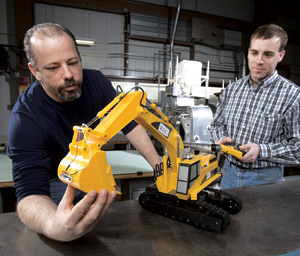 |
| Photo: Reidar Hahn, Fermilab |
Caterpillar crawls to a high-energy rescue
Ryan Schultz and Kris Anderson had a problem: how to inspect a window in a pipe that carries a powerful particle beam, 40 feet below ground and 100 feet down a narrow tunnel.
Their solution: a 15-foot-long contraption that combines a digital camera, a toy Caterpillar excavator, and a scaled-up version of the periscope children use to peer over the backs of sofas. It cost just $200, not bad for a tool that is key to the well-being of a multi-milliondollar experiment at Fermi National Accelerator Laboratory in Illinois.
Directed via a 100-foot remote control cord, the bright yellow excavator rolled into the tunnel, bathed the window in LED light and trained a spotting telescope on it. Watching through a periscope inserted into an access shaft, inspectors on the surface snapped pictures.
The photos came out perfect, and a video of the inspection kept Schultz's 5-year-old son entertained for days.
“He wanted RIC to go with his other toy cars,” Schultz says. As for RIC, or Remote Illumination Caterpillar, “he's like a person,” Schultz says. “He had his own identity. There's nothing complicated about him. He just does his job.”
The window is in a decay pipe linking Fermilab's Main Injector with NuMI, an experiment that shoots a beam of neutrinos through the ground to a detector in Minnesota. It must be periodically inspected for corrosion and other wear and tear.
But since the pipe is encased in concrete, wireless devices won't work, and the low level of radiation in the tunnel fogs photos taken down there.
So Schultz and his supervisor, engineer Kris Anderson, drew on a deep well of experience: hours spent driving remote-controlled cars with their kids.
Meanwhile, senior technician Keith Anderson knew from his days working on US Army tanks that he could devise a periscope to look into the tunnel. “It is mostly modeled after the children's milk-bottle periscope, a box with two mirrors on it,” he says.
In the end, Schultz jokes, one of the most difficult parts of the project was getting reimbursed: “Think about it. I submitted a receipt that says Toys 'R' Us.”
Tona Kunz
Click here to download the pdf version of this article.






